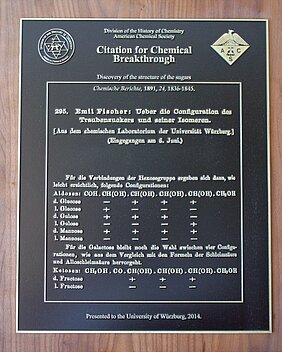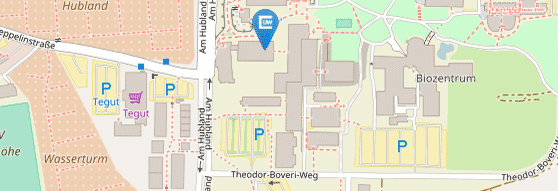"Historical" Award for the Institute of Organic Chemistry
09/14/2015The Institute of Organic Chemistry receives one of 2014’s American Chemical Society’s Citation for Chemical Breakthrough awards for the outstanding work of Emil Fischer "About the Configuration of glucose and its isomers".
In a public ceremony on October 7, 2015, the Institute of Organic Chemistry will receive the Citation for Chemical Breakthrough award 2014 of the Division of the History of Chemistry der American Chemical Society (HIST ACS). This award program honors publications, patents and books worldwide that have made breakthroughs in the field of chemistry. The criteria are very strict, which means that the advances in chemistry must have been revolutionary in concept, broad in scope, and long-term in impact.
The award is given to the institution from which the award winning material was published rather than to the authors or inventors themselves, should they be alive. It was first presented in 2006 and after the university of Kiel (2011) the university of Würzburg is the second German university that gets this award.
Emil Fischer, carried out research in Würzburg from 1885 to 1892, is one of the most well-known German chemists. His name is inseparably linked with the chemistry of sugars. Even today, each German high school student has to learn the Fischer projection formula of sugars,
Therefore is it not surprising that the award committee selected the publication of Emil Fischer „Über die Configuration des Traubenzuckers und seiner Isomeren“ ("About the Configuration of glucose and its isomers") in "Chemische Berichte" from 1891. Also from today's perspective his research is still a brilliant feat of scientific art of experimentation and sharp mind. This becomes even more apparent when considering that at that times there were no modern spectroscopic analytical methods for the elucidation of the structure of a chemical compound such as nuclear magnetic resonance spectroscopy or infrared spectroscopy. Even the formula language of chemistry as we know it today, was still in its infancy and was far from being generally accepted.
Beside that Emil Fischer had to struggle with lack of space, primitive laboratory conditions and inadequate ventilation systems when he came to Würzburg in 1885, so that certain types of work could not be performed for technical reasons. From the outset he therefore endeavored to bring about a new institute building, which was finally granted to him in 1892 and led to the establishment of the most advanced chemistry laboratories of his time in Würzburg.



